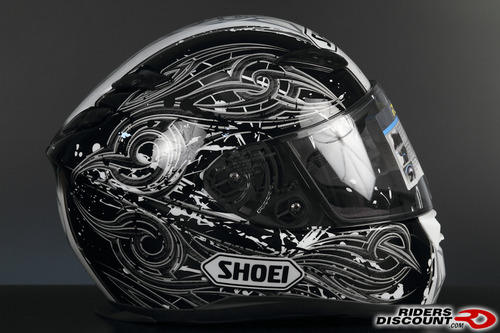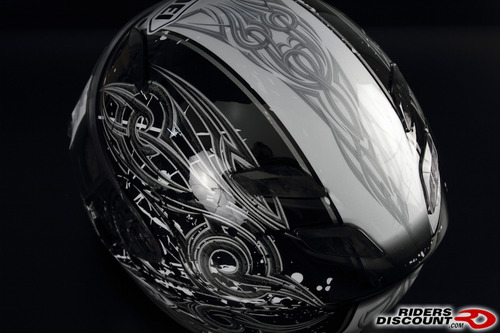Shoei’s engineers took everything that drew complaints from users of the older RF1000 (not that it was a bad helmet!) and integrated it into the new RF1100. The new helmet now includes a fully removable liner, improved ventilation, better anti-fog capabilities and a self-adjusting visor, mechanism among other things. There’s also an improvement with regard to safety as the new helmet meets Snell 2010 safety standards.
For starters, all three of the helmet’s front intakes have been improved: the chin vent is wider and the forehead intakes, while they look similar to the RF-1000’s – have been smoothed when compared to the older version. The new design removed the burrs found on the RF-1000’s intakes resulting in less whistling (not that Shoei motorcycle helmets were loud to begin with) and the new shape of the upper intakes improves airflow, maximizing cool air coming into the helmet.
The chin vent doesn’t function like one would expect when looking at the helmet from the outside as it does not let air straight through, but rather, deflects it upwards along the inside of the faceshield. In this manner, air is circulated over the face and drawn up through intakes at the top on the inside of the eyeport. While it keeps the rider cool, this ventilation design also has the effect of preventing the visor from fogging. Shoei also claims the new design is easier to use with gloved hands, though we have not been able to tell any real difference between the RF-1000’s and the RF-1100’s open/close mechanisms.
The most noticeable difference between the new helmet versus the old, is the RF-1100’s shape. While the RF-1000 had a large plastic spoiler glued onto the rear, the new version has a spoiler molded into the shell. This design, drawn from a Shoei Moto helmet, not only improves helmet stability by reducing wind buffet, but it also creates a vacuum that aids in ventilation. During testing, Shoei’s engineers noticed that the best way to remove air from the helmet was by moving the vents higher than previously thought logical.
There are now four vents on the back of the RF-1100, compared to the older model’s two. These vents are all individually closeable and they’re large enough to be easily operated with gloved hands. What’s interesting, is that Shoei claims there are six vents on the back of this helmet, the four we just mentioned along with two more at the bottom of the helmet. We had to look hard to find the latter two as they’re hidden at the bottom of the helmet’s neck roll, on the other side of the liner. Here again, Shoei takes advantage of the negative pressure found behind the rider’s body where air inside the helmet is continuously sucked out, drawing with it heat generated from the user’s head.
Speaking of unseen ventilation, the entire EPS liner is a ventilation system. Channels are molded into the two-piece design that draw air from the front of the helmet, over the user’s head, to the back and out into the atmosphere through the already-mentioned intakes and exhausts.
As noted, the new helmet meets the new Snell M2010 standard that brings it into line with the popular, and some would say, safer – ECE rating found on many European helmets. Shoei’s Advanced Integrated Matrix Plus Multi Fiber (AIM+) shell construction gives this helmet a lightweight, yet strong shell. This design combines five layers of differing, fibrous compounds that provide the same kind of strength as a standard fiberglass shell yet, weighs in at a significantly less amount than would be expected. Not only do these shells stand up well to penetrating impacts but they also dissipate the impact load over a greater area, increasing user survivability.
Another annoyance Shoei has addressed with the RF-1100 is the visor system. The new CW-1 shield system is anchored to the helmet with Quick-Release Self-Adjusting (QRSA) visor base plates. The design makes swapping out visors very easy, so long as you’re not wearing the helmet, though, with a talented hand, you can probably do it with the bonce mounted on your head. The system also automatically draws the visor evenly over the entire eyeport gasket – no more rain or wind getting in because you didn’t fit the visor correctly. The eyeport is also wider and taller than the old model for an improved field of vision. What’s more, if you own a Shoei X-Twelve, it will be possible to swap visors between the two different helmets. There’s also nearly 100% UVA/UVB protection offered by the new scratch-free lenses. No more red face after a day’s ride.
As is standard on top-of-the-line Shoei motorcycle helmets, a chin skirt and breath deflector come standard in the box along with clear instructions and cleaning materials for the new lid. The chin skirt blocks out the space left between the bottom of the rider’s chin and the helmet, keeping wind off the face in colder weather. The breath deflector helps the already fog-resistant visor, keep from fogging up too.
Surprisingly, the RF-1100 is two tenths of a pound heavier than the older model for the same sized helmet, but the manner in which comfort has been improved makes this additional weight negligible. The new helmet addressed many of the complaints we had of the older RF-1000 model and some things we didn’t really find bothersome. The improved ventilation will certainly be welcome to those riding in hotter climates and the new shell’s shape will turn heads (though, not yours!) wherever you go.
Latest posts by Riders Discount (see all)
- Alpinestars Tech-Air Race Airbag System - September 12, 2018
- Shoei X-Fourteen Marquez 5 Helmet - September 11, 2018
- Cortech Adrenaline 3.0 RR Gloves - September 4, 2018






